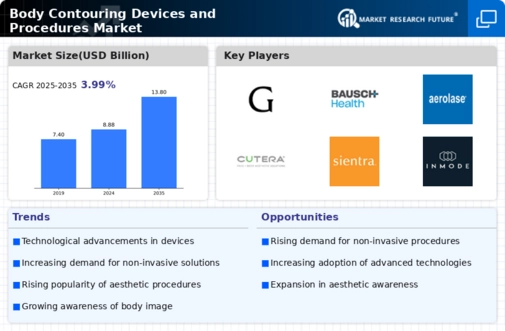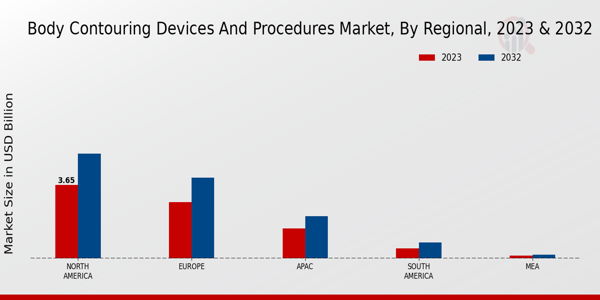Market Trends
Introduction
The Body Contouring Devices and Procedures Market is expected to experience significant growth by 2023, with a number of macro-economic factors at play. Technological advancements in non-surgical and minimally invasive procedures are reshaping customer preferences and increasing the demand for new and improved solutions. Regulatory pressures are also influencing the market, with companies and operators having to contend with evolving safety and regulatory standards. In addition, changes in consumer behaviour, such as a greater focus on aesthetic health and body-positive thinking, are driving an increased demand for body contouring services. These macro-economic factors are of strategic importance to industry players, as they not only highlight emerging opportunities, but also require a proactive approach to adapt to the dynamic market landscape.
Top Trends
-
Increased Demand for Non-Invasive Procedures
There is a growing preference for non-surgical body sculpting procedures, driven by the growing awareness of consumers and the technological advances. According to industry reports, non-invasive procedures will account for more than 70% of the total body sculpting market in 2022. To meet this demand, companies have been expanding their product portfolios with new products like Coolsculpting and Emsculpt. Patients are increasingly seeking quick recovery and fewer side effects. -
Integration of AI and Machine Learning
Machine learning and artificial intelligence are used to increase the precision and efficacy of body-contouring devices. Using data analysis, companies are developing intelligent machines that can adapt treatments to each patient. For example, artificial intelligence-based devices can anticipate patients’ responses and thus improve their satisfaction. This trend will lead to more individualized treatment plans, increasing efficiency and the likelihood of patient adherence. -
Regulatory Support for Innovative Technologies
Regulatory authorities are now increasingly promoting the development of body contouring techniques and facilitating the approval of new devices. The FDA has shortened the approval process for non-invasion devices, thus encouraging investment in R & D. This regulatory framework is conducive to innovation and facilitates the introduction of new solutions on to the market. The next stage of development could well see the emergence of devices which combine several modalities to achieve better results. -
Rise of Combination Therapies
Combination treatments that combine body contouring with other aesthetic procedures are also gaining in popularity. Clinics are offering packages of combined treatments, such as combining liposuction with skin-tightening treatments. This not only improves the results but also increases turnover per patient. As the demand for complete solutions grows, it will be necessary to adapt the service offerings to remain competitive. -
Focus on Safety and Efficacy
The companies in the field of body sculpting continue to make an investment in clinical trials to validate their devices. Recent studies have shown that, when it comes to choosing a product, patients put safety above price. The result is that manufacturers are putting clinical data at the center of their advertising strategy. This trend will undoubtedly push the development of more effective and safer devices in the coming years. -
Emergence of At-Home Devices
The appearance of body-contouring devices at home is reshaping the access of consumers to treatments. Hand-held ultrasound and radiofrequency devices are becoming popular among consumers looking for more convenience. The at-home market is expected to grow significantly, as consumers are looking for cost-effective solutions. This trend may force the business model of traditional clinics to include remote consultation and support. -
Sustainability in Product Development
In the development of body-shaping devices, the companies are increasingly seeking materials and methods that are in harmony with the environment. For example, the companies are exploring biodegradable components and energy-efficient technologies. This not only appeals to consumers who are concerned about the environment, but it also fits in with the goals of global sustainability. In the future, it is possible that the industry will receive certification for sustainable practices. -
Telemedicine and Virtual Consultations
Telemedicine is changing the way body-contouring consultations are conducted, allowing for remote assessment and follow-up. Clinics are using the virtual world to reach a wider audience, especially in underserved areas. Since 2020, the number of teleconsultations has grown by more than 50%. This trend is expected to continue, improving access to care and potentially growing the market. -
Personalization through Genetic Testing
Personalization of body sculpting is advancing with the use of genetic testing to determine the most appropriate treatment. Companies are exploring how genetic profiles affect the distribution of fat and the effectiveness of treatments. This new approach could result in better, more individualized treatment plans. In the future, genetic testing may become a standard procedure. -
Expansion into Emerging Markets
A new body shaping device is being developed, and it is becoming increasingly important in the market for body sculpting, as rising living standards and changing beauty standards are bringing new customers into the market. Asia and Latin America are experiencing a boom in demand for body sculpting. Strategic companies are establishing themselves in these markets to exploit this growth. Localization of products and services will follow this trend to meet the various preferences of consumers.
Conclusion: Navigating the Body Contouring Landscape
The market for body contouring procedures in 2023 is characterised by intense competition and significant fragmentation, with both established and new players competing for market share. The regional trends point to a growing demand in North America and Asia-Pacific, which is forcing suppliers to adopt a more regionally based strategy. The established players are using their strong brand name and their established distribution network to maintain their market position, while the newer companies are concentrating on technological innovations and a more customer-friendly approach. The key factors are the integration of AI, the automation of procedures, the sustainable development of products and the flexibility of operations. As a decision-maker, you must align your organisation with these capabilities in order to maintain a competitive advantage.












Leave a Comment